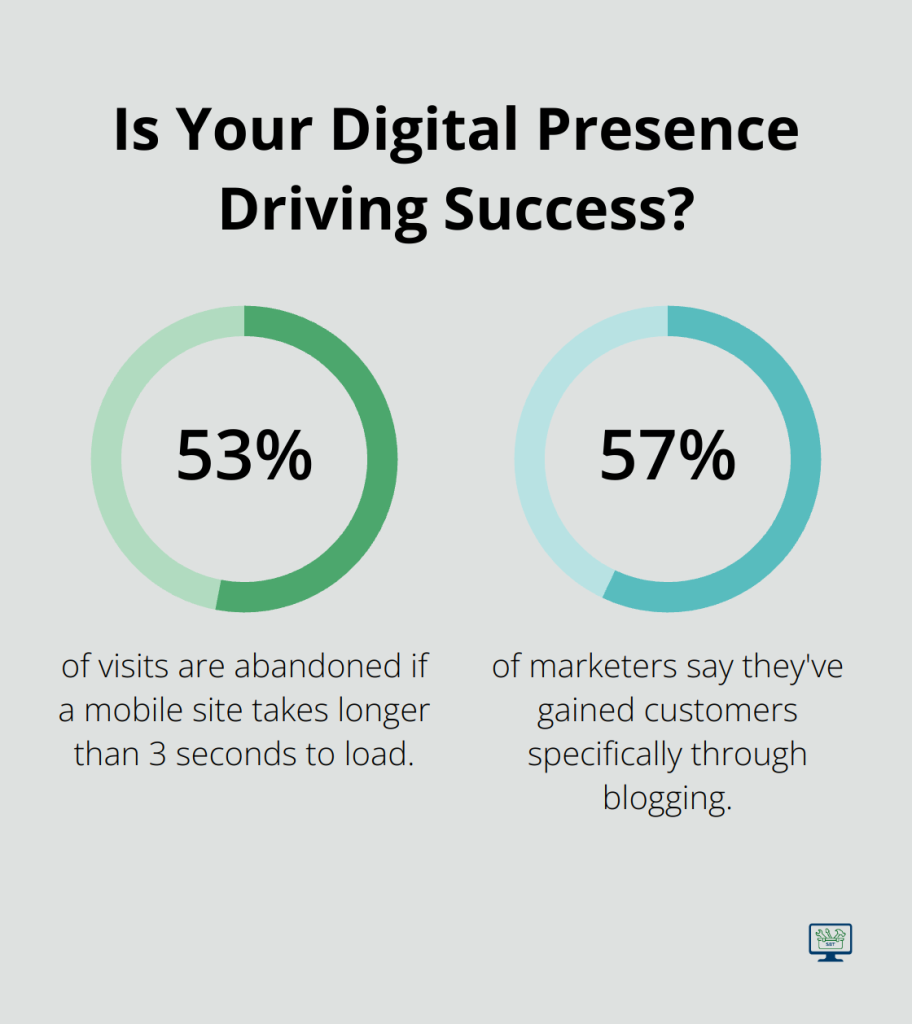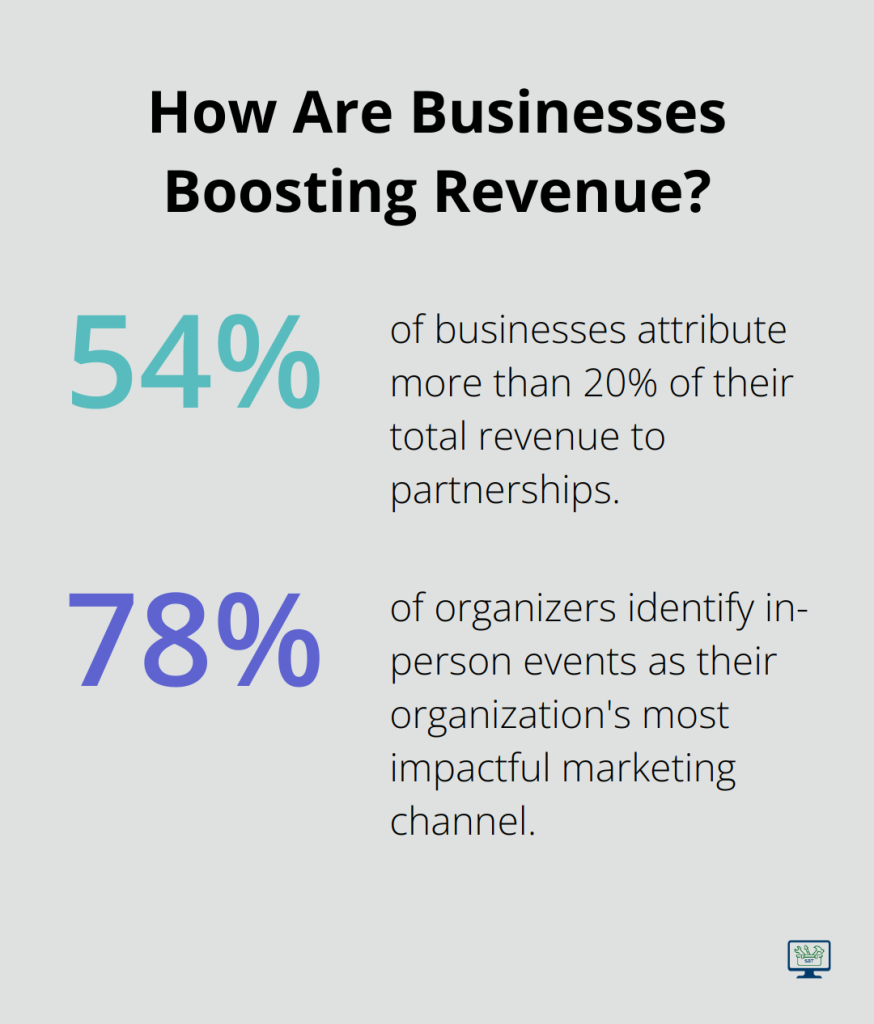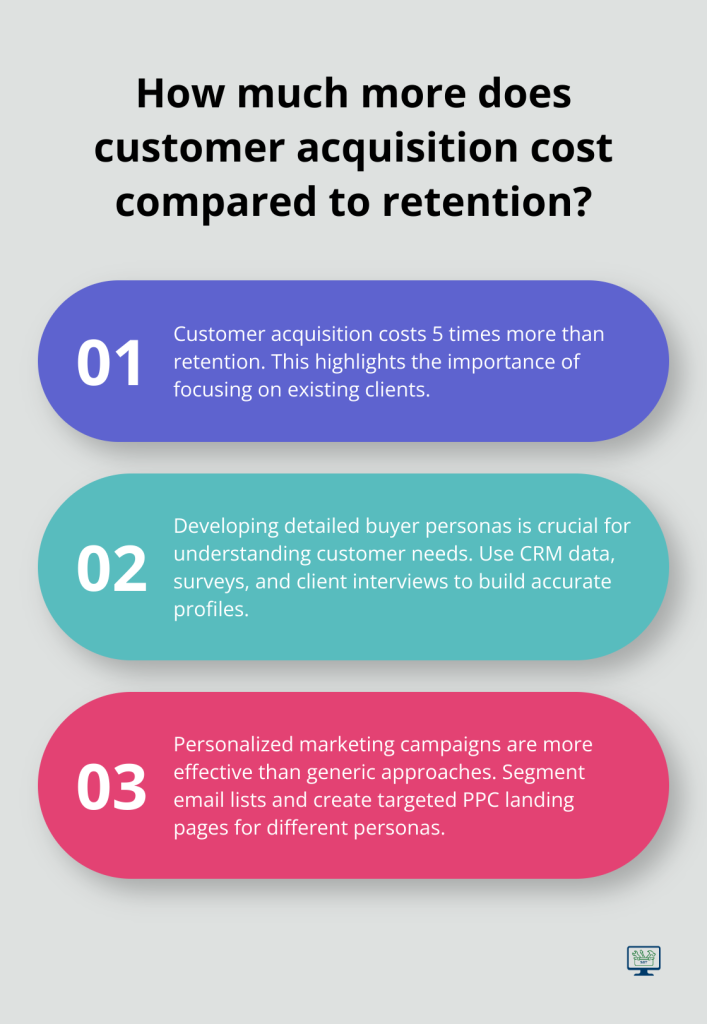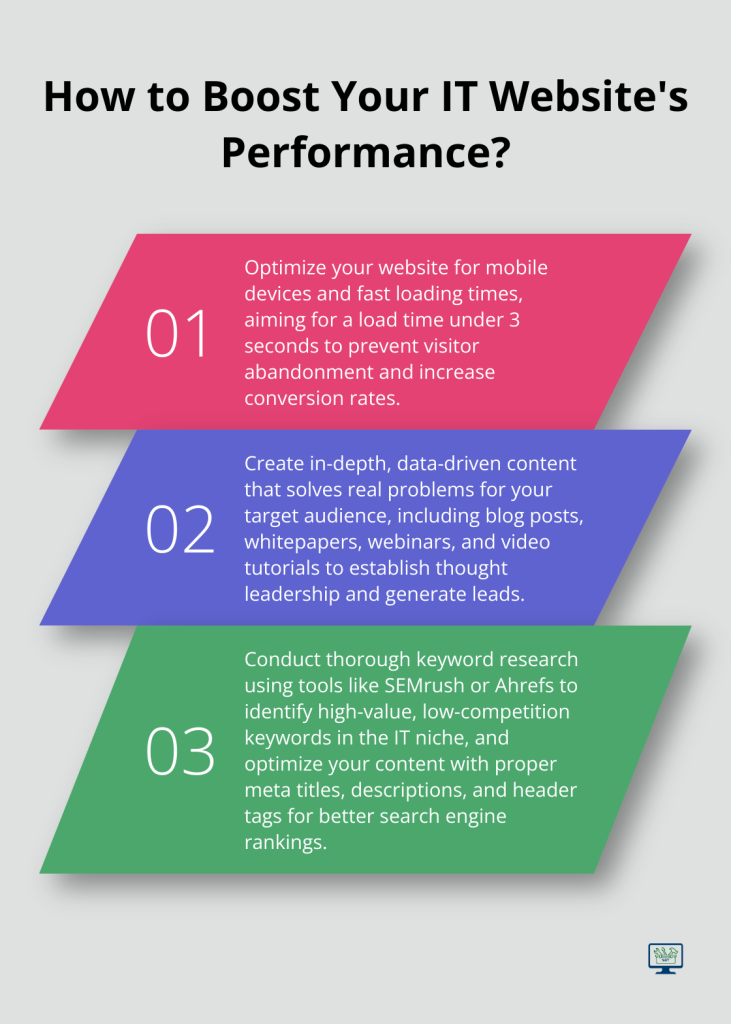IT businesses face unique challenges in attracting and retaining clients. A solid marketing strategy for IT businesses is essential for standing out in a crowded market.
At SmallBizToolbox, we’ve seen firsthand how the right approach can transform an IT company’s growth trajectory. This post explores proven marketing tactics that drive real results for tech-focused enterprises.
How IT Businesses Can Dominate Digital Marketing
In today’s tech-driven landscape, IT businesses must harness the power of digital marketing to stand out. Many IT companies struggle to gain traction online, but with the right approach, digital marketing can transform their growth trajectory.
Create a Powerful Online Presence
Your website serves as your digital storefront. It needs to function as a lead-generating machine. Start by ensuring your site responds to mobile devices and loads quickly. 53% of visits are abandoned if a mobile site takes longer than 3 seconds to load.

Focus on user experience (UX) next. Investing in user experience improvements can yield substantial increases in conversion rates. Make navigation intuitive, use clear calls-to-action, and showcase your IT expertise through case studies and client testimonials.
Establish Thought Leadership Through Content
Content marketing establishes authority in the IT sector. Don’t produce generic tech articles. Instead, create in-depth, data-driven content that solves real problems for your target audience.
Start a blog that addresses common IT challenges businesses face. 57% of marketers say they’ve gained customers specifically through blogging. Diversify your content with whitepapers, webinars, and video tutorials. These not only demonstrate your expertise but also serve as valuable lead magnets.
Climb Search Engine Rankings
SEO attracts organic traffic to IT businesses. Conduct thorough keyword research to understand what potential clients search for. Tools like SEMrush or Ahrefs (SmallBizToolbox offers similar functionality) help identify high-value, low-competition keywords in the IT niche.
On-page SEO matters equally. Optimize meta titles, descriptions, and header tags. Structure your content with proper H1, H2, and H3 tags. Don’t neglect technical SEO – site speed, mobile-friendliness, and secure HTTPS all factor into Google’s ranking algorithm.
Maximize ROI with PPC Advertising
While organic traffic provides long-term benefits, PPC advertising delivers quick results. Platforms like Google Ads allow you to target specific keywords and appear at the top of search results instantly.
Successful PPC for IT businesses requires laser-focused targeting. Use negative keywords to filter out irrelevant traffic. Craft compelling ad copy that addresses your ideal client’s pain points directly. Always use dedicated landing pages for PPC campaigns – they can increase conversions by up to 25%.
Digital marketing for IT businesses demands constant monitoring and optimization. These tactics will set you on the path to dominate the digital landscape and attract high-quality leads. As you implement these strategies, consider how building strategic partnerships can further amplify your marketing efforts.
How to Forge Powerful IT Industry Partnerships
Strategic partnerships transform IT businesses. Here’s how to build alliances that drive results.
Find Your Perfect Match
Identify businesses that complement your IT services. Look for companies that share your target market but don’t directly compete. If you specialize in cybersecurity, partner with cloud storage providers or managed service providers (MSPs).

A study by the Business Performance Innovation Network revealed that 54% of businesses attribute more than 20% of their total revenue to partnerships. To uncover these opportunities, analyze your client base. What other services do they frequently need? Those gaps represent your partnership sweet spots.
Become a Conference Powerhouse
Industry events offer rich networking opportunities. Don’t just attend – stand out. Speak at conferences to establish yourself as an expert. A survey found that 78% of organizers identify in-person events as their organization’s most impactful marketing channel.
Research attendees and schedule meetings before the event. Follow up within 48 hours after making connections. Attend the same events annually to build lasting relationships.
Master LinkedIn for B2B Connections
LinkedIn isn’t just for job hunting – it’s a B2B powerhouse (with over 700 million users). Optimize your company page. Use keywords relevant to your IT niche in your description and posts.
Engage consistently. Share industry insights, comment on posts from potential partners, and participate in relevant groups. A study found that a 1% increase in the number of social posts leads to a 0.294% increase in engagement (from week 0 to week 2).
Reach out directly. Personalize your connection requests and follow up with value-add messages. Focus on building relationships first, not selling.
Launch High-Impact Joint Ventures
After building solid relationships, collaborate. Joint ventures in the IT world take many forms. Co-develop a new software solution, create a bundled service offering, or team up for a major client pitch.
Structure partnerships that benefit both parties. Define roles, responsibilities, and revenue sharing upfront. Use project management tools to keep collaborations on track.
The Microsoft and OpenAI partnership exemplifies successful collaboration, leading to groundbreaking AI advancements that benefit both companies and push the entire tech industry forward.
Strategic partnerships amplify your reach and resources. These actionable steps will help you build a network that fuels your IT business growth. Now, let’s explore how customer-centric approaches can convert these new connections into loyal clients.
How IT Businesses Can Put Customers First
Technology-first strategies prioritise the integration of advanced technologies into every facet of business operations. This chapter explores effective strategies to prioritize customer needs and drive business success.
Create Detailed Buyer Personas
IT companies must develop comprehensive buyer personas. These profiles go beyond demographics to uncover customer challenges, goals, and decision-making processes. Use CRM data, conduct surveys, and interview top clients to build accurate personas.

For instance, when targeting small business owners who need IT support, identify their specific concerns. Do they worry about cybersecurity? Do they face challenges with remote work setups? Use these insights to tailor your messaging and services effectively.
Implement Personalized Marketing Campaigns
Generic marketing fails to engage modern consumers. Leverage buyer persona data to create targeted campaigns.
Segment your email list based on industry, company size, or specific IT needs. Send content that addresses each group’s unique challenges. For PPC ads, create distinct landing pages for different personas, directly addressing their pain points.
Showcase Customer Testimonials
Client feedback builds trust. Actively collect and display customer testimonials.
Take a proactive approach to gathering reviews. Request detailed feedback after successful project completion. Use video testimonials or case studies to bring success stories to life. Share these across your website, social media, and sales materials (this approach amplifies your credibility).
Provide Exceptional Customer Service
Service quality can make or break client relationships in the IT world. Train your team to excel in both technical expertise and communication skills. Explain complex IT concepts simply, and keep clients informed throughout projects.
Implement a robust ticketing system to track and resolve issues quickly. Set clear Service Level Agreements (SLAs) and consistently meet or exceed them. Consider offering 24/7 support for critical services (this can significantly differentiate your business in the IT space).
Prioritize Customer Retention
Acquiring new customers costs five times more than retaining existing ones. Focus on building long-term relationships with your current client base. Regular check-ins, personalized offers, and loyalty programs can strengthen these connections.
Conduct periodic reviews of your services with clients to ensure continued satisfaction. Address any issues promptly and proactively suggest improvements or upgrades that align with their evolving needs. Embrace technology to enhance customer retention. Implement a CRM system to track customer interactions and preferences. Use AI-powered chatbots for instant customer support and engagement.
Final Thoughts
A robust marketing strategy for IT businesses combines digital dominance, strategic partnerships, and customer-centric approaches. These tactics work together to attract, engage, and retain clients in the competitive tech landscape. IT companies must create a strong online presence, leverage content marketing, and optimize for search engines to increase visibility and lead generation.

Strategic partnerships amplify an IT company’s reach and capabilities. IT firms can expand their service offerings and tap into new markets through complementary business relationships, industry event networking, and joint ventures. Customer-centric approaches, including personalized marketing campaigns and exceptional service, build lasting relationships and drive business growth.
IT businesses must adapt their marketing strategies as technology and market trends evolve. SmallBizToolbox offers a comprehensive suite of resources designed for small business growth in Australia. Our tools support efficient execution of effective marketing strategies for IT businesses (from AI-driven content creation to SEO optimization).
How useful was this Resource?
Click on a star to rate it!
Average rating 0 / 5. Vote count: 0
No votes so far! Be the first to rate this post.
We are sorry that this post was not useful for you!
Let us improve this Resource!
Tell us how we can improve this Resource?




